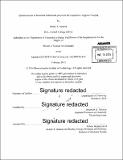| dc.contributor.advisor | Jeremiah A. Johnson. | en_US |
| dc.contributor.author | Sowers, Molly A. (Molly Ann) | en_US |
| dc.contributor.other | Massachusetts Institute of Technology. Department of Chemistry. | en_US |
| dc.date.accessioned | 2015-07-31T19:12:09Z | |
| dc.date.available | 2015-07-31T19:12:09Z | |
| dc.date.copyright | 2014 | en_US |
| dc.date.issued | 2015 | en_US |
| dc.identifier.uri | http://hdl.handle.net/1721.1/97989 | |
| dc.description | Thesis: S.M., Massachusetts Institute of Technology, Department of Chemistry, February 2015. | en_US |
| dc.description | Cataloged from PDF version of thesis. "February 2015." | en_US |
| dc.description | Includes bibliographical references (pages 61-65). | en_US |
| dc.description.abstract | Multi-modality and stimuli responsive nanoparticles are promising platform materials for medical imaging and diagnostics. Specifically magnetic resonance imaging (MRI) and nearinfrared (NIR) fluorescent probes can be used in combination to visualize biodistribution and in vivo clearance rates. We reasoned that through the use of a nitroxide radical MRI contrast agent along with a NIR fluorophore it would be possible to study these phenomena along with nitroxide reduction in vivo. Thus, we have developed branched bottlebrush copolymers that display compensatory fluorescence response to nitroxide reduction that enables correlation of MRI contrast, fluorescence intensity, and spin concentration in tissues. These polymers were synthesized by ring-opening metathesis copolymerization of two new branched macromonomers: one carries a bis-spirocyclohexyl nitroxide and the other the NIR dye Cy5.5. Promising preliminary results with the resulting polymers in solution MRI and NIR imaging studies as well as in vitro toxicity led us to explore the potential of these materials for in vivo applications. Though nitroxide agents are promising organic agents for MRI applications, clinically, gadolinium-based MRI contrast agents are most common due to their high relaxivity and relatively low toxicity when bound to chelating ligands. We have also explored the idea of incorporation of gadolinium agents into our branched bottlebrush copolymer platform through the design of Gd-based branched macromonomers. While the fluorescence redox effects described in the nitroxide system above would not be applicable, chelated Gd could be used in much smaller concentration to provide similar MRI contrast. In this way, a small percentage of Gd could be added as an MRI tag to any polymer synthesized by ROMP. A natural extension of the work described above is the incorporation of cellular targeting moieties for tissue-selective imaging. Toward this end, we propose the incorporation of known cellular targeting ligands onto the surface of branched bottlebrush polymers through the synthesis of end-functionalized branched macromonomers. The synthesis of several targeting ligands is described, alongside synthesis and characterization of positively charged nanoparticles for improved cellular uptake and ionic coordination of hyaluronic acid or other negatively charged polymers. | en_US |
| dc.description.statementofresponsibility | by Molly A. Sowers. | en_US |
| dc.format.extent | 65 pages | en_US |
| dc.language.iso | eng | en_US |
| dc.publisher | Massachusetts Institute of Technology | en_US |
| dc.rights | M.I.T. theses are protected by copyright. They may be viewed from this source for any purpose, but reproduction or distribution in any format is prohibited without written permission. See provided URL for inquiries about permission. | en_US |
| dc.rights.uri | http://dspace.mit.edu/handle/1721.1/7582 | en_US |
| dc.subject | Chemistry. | en_US |
| dc.title | Advancements in branched bottlebrush polymers for responsive, targeted imaging | en_US |
| dc.type | Thesis | en_US |
| dc.description.degree | S.M. | en_US |
| dc.contributor.department | Massachusetts Institute of Technology. Department of Chemistry | |
| dc.identifier.oclc | 914235472 | en_US |
